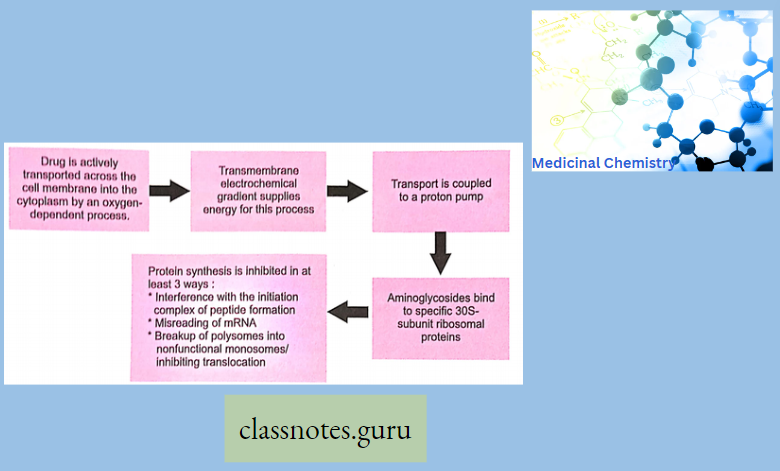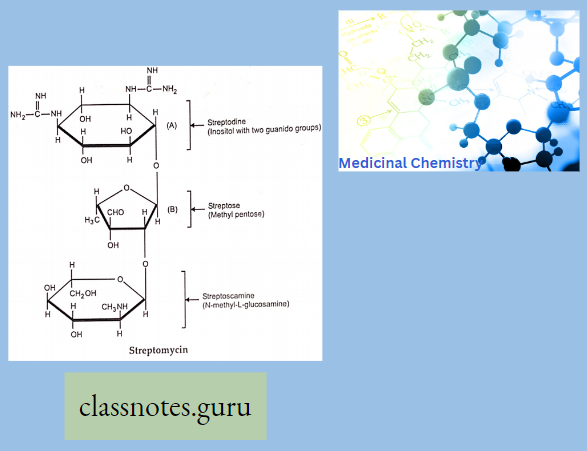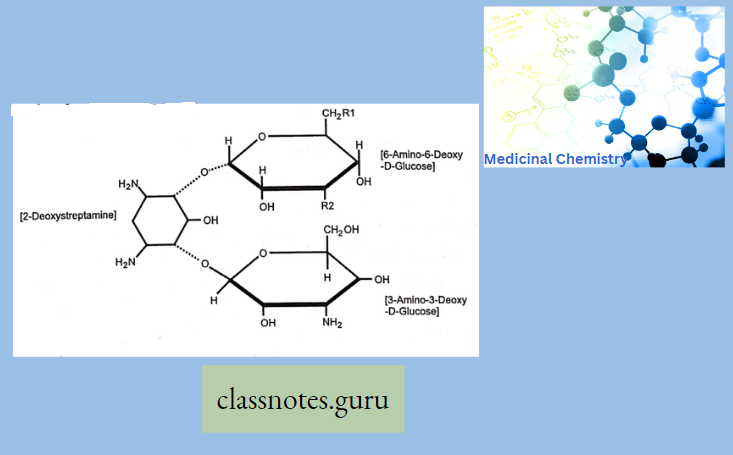Amino Glycosides Introduction
Aminoglycoside is a medicinal and bacteriologic category of traditional Gram-negative antibacterial therapeutic agents that inhibit protein synthesis and contain as a portion of the molecule an amino-modified glycoside (sugar).
- The term can also refer more generally to any organic molecule that contains amino-sugar substructures.
- The aminoglycoside antibiotics contain one or more amino sugars linked to an aminocytitol ring by glycosidic bonds.
- Aminoglycoside antibiotics display bactericidal activity against Gram-negative aerobes and some anaerobic bacilli were resistant to Gram-positive and anaerobic Gram-negative bacteria. Streptomycin is the first antibiotic of this group.
Aminoglycosides
- Systemic aminoglycosides
- Streptomycin Amikacin
- Gentamicin
- Sisomicin
- Kanamycin
- Netilmicin
- Tobramycin
- Paromomycin
Topical Aminoglycosides
- Neomycin
- Framycetin
Amino Glycosides Mode Of Action
The aminoglycosides exhibit bactericidal effects as a result of several phenomena. Klbosomal binding on the 30s and SOs subunits as well as (the interface produces misreading; this is normal protein synthesis, Cell membrane damage also plays an integral part in ensuring bacterial cell death.
Read and Learn More Medicinal Chemistry III Notes

Amino Glycosides Adverse Effect
The aminoglycoside can produce severe adverse effects, which include nephrotoxicity, ototoxicity, and neuro effects.
These properties have limited the use of aminoglycoside chemotherapy to serious systemic indications.
Amino Glycosides Classification
Streptomycin: It is used in the treatment of infections caused by gram-negative bacteria of particular interest and has a high degree of activity against P. aeruginosa, where the important causative factor is burned skin. It is used topically in the treatment of infected bed sores, pyodermata, burns, and eye infections.

Neomycin: It is photosensitive and its main use is in the treatment of ear eye and skin infections This includes burns wounds nuclear and infected dermatoses.

Tobramycin: Its activity is similar to gentamycin. The superior activity of tobramycin against P. aeruginosa may make it useful in the treatment of bacterial osteomyelitis and pneumonia caused by Pseudomonas species.

Sar Of Amino Glycoside
The aminoglycosides consist of two or more amino sugars joined in glycoside linkage to a highly substituted 3 diaminocyclo hexane (amino cyclitol), which is a centrally placed ring.
- The ring is a 2-deoxy streptamine in all aminoglycosides except streptomycin and dihydrostreptomycin, where it is streptidine. Thus,
- In the kanamycin and gentamycin families, two amino sugars are attached to 2-deoxy streptamine.
- In streptomycin, two amino sugars are attached to strepidine.
- In the neomycin family, there are amino sugars attached to 2-deoxy streptamine.
The aminoglycoside antibiotics contain two important structural features. They are amino sugar portions and centrally placed hexose rings, which are either 2-deoxystreptamine or streptidine.
Amino Sugar Portion
The bacterial inactivating enzymes target C-6 and C-2 position and the substitution with methyl group at C-6 increases the enzyme resistance. Cleavage of 3-hydroxyl or the 4-hydroxyl or both groups does not affect the activity.
Centrally Placed Hexose Ring (Aminocyclitol Ring): Various modifications at the C-l amino group have been tested.
- The acylation (for example amikacin) and ethylation (for example 1-N-ethylsisomycin) though do not increase the activity help to retain the antibacterial potency.
- In the sisomicin series, 2-hydroxylation and 5-deoxygenation result in the increased inhibition of bacterial inactivating enzyme systems.
- Thus, very few modifications of the central ring are possible, which do not violate the activity spectrum of aminoglycosides.
Amino Glycosides Multiple Choice Questions
Question 1. Which effect is related to aminoglycoside
- Gray baby syndrome
- Ototoxicity
- Fanconi syndrome
- None
Answer: 2. Ototoxicity
Question 2. Amino glycoside gives.
- Bactericidal effect
- Bacteriostatic effect
- Fungicidal effect
- None
Answer: 1. Bactericidal effect
Question 3. How aminoglycosides act as …
- Act on 30s ribosome
- Framacitin
- Both 30s and 50s
- None
Answer: 3. Both 30s and 50s
Question 4. Which aminoglycoside is used as topical?
- Neomycin
- Framacitin
- Both
- None
Answer: 3. Both
Question 5. Which linkage is found in the aminoglycoside ring and sugar
- Glycosidic linkage
- Hydrogen Bonding
- Covalent Bond
- All
Answer: 1. Glycosidic linkage
Amino Glycosides Short Question And Answers
Question 1. What is the mode of action of aminoglycoside?
Answer:
Mode Of Action Of Aminoglycoside: The aminoglycosides exhibit bactericidal effects as a result of several phenomena. Ribosomal binding on 30s and 50s subunits as well as the interface produces misreading; this disturbs the normal protein synthesis.
Question 2. What is the structure of neomycin?
Answer:
Structure Of Neomycin

Question 3. What is the role of the amino cyclitol ring in the SAR of aminoglycoside?
Answer:
Role Of The Amino Cyclitol Ring In The SAR Of Aminoglycoside: Various modifications at the C-l amino group have been tested. The acylation (for example, amikacin) and ethylation (for example 1-N ethylsisomycin) though do not increase the activity help to retain the antibacterial potency.
Question 4. What is the common adverse effect of aminoglycoside?
Answer:
Common Adverse Effects Of Aminoglycoside: Aminoglycoside can produce severe adverse effects, which include nephrotoxicity, ototoxicity, and neuro effects. These properties have limited the use of aminoglycoside chemotherapy to serious systemic indications
Question 5. What are aminoglycosides?
Answer:
Aminoglycosides: Aminoglycoside is a medicinal and bacteriologic category of traditional Gram-negative antibacterial therapeutic agents that inhibit protein synthesis and contain as a portion of the molecule an amino-modified glycoside (sugar).
- The term can also refer more generally to any organic molecule that contains amino-sugar substructures.
- The aminoglycoside antibiotics contain one or more amino sugars linked to an aminocytitol ring by glycosidic bonds.
